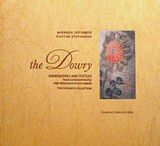The art of embroidery is a very ancient art. With needle and stitches, with loom and threads, women revealed their sensitivity, cultivated their imagination, wove their dreams. Vast embroidered fields travelled from East to West, becoming links in a chain of art and communication.
Linen and silk textiles were produced by womens skillful hands, were transformed into costumes and trousseaus to adorn persons and homes on high-days and holidays. Customs and traditions, joys and sorrows have continued to travel for centuries now in linen and in silk with colourful threads; trees and flowers, carnations, tulips and pansies, motifs enclosing stories and fairytales, pass down the generations and set their seal on cultures old and new, so that they are not forgotten.
Richly-embroidered covers adorn beds, mirrors, chests, cushions and bolsters. Two-sided needlework, difficult but delightful in its execution, harks back to Byzantine times. Silver, pure gold and golden thread, combined with the many colours of dyed silk threads, shimmer like jewels.
The stitches, magical words just to hear, become poems, become embroideries: rizovelonia (stem stitch), trypiti (buttonhole stitch), alysidoti (chain stitch), richti (whipstitch), chyti and travichti (for drawn-thread work), kophto (for cut-work), psathoti (basket stitch), perasti (darning stitch), cevrovelonia (two-sided stitch used on cevres), gazovelonia (double running stitch). Their magic suffuses the womens handiwork, composing surfaces of precious artistry, poetry and musicality, hymning an entire culture.
Pergamon and Constantinople, Constantinople and Pergamon, the two places represented in the collection. Both also the places of origin of two people, Aristodemos and Myrsine, who joined their lives and who bequeathed to posterity this living treasure-chest of memory.
Constantinople as metropolis of Byzantine minor arts, with a history of imperial patronage of its eponymous weavers and embroiderers, was source of the trend of decorating even humble houses after imperial models. From the eighteenth century, however, Constantinople was a vibrant multi-ethnic city, where the East with its habits and culture encountered and interacted with the West. Diplomats, scholars and men of letters hosted and attended European-style receptions, and the ladies appearances were impressive to say the least. Their demand for dresses, hats, jewellery was constant and the diverse workshops received commissions every day.
Alongside the attire, the dowries were prepared too. Apprentices and experienced craftswomen, and of course male embroiderers, in their own workshops in Constantinople, undertook the most difficult embroideries. For the serious needs of the dowry, which had to be finished when the time came, nuns in the convents and embroidresses in the homes played their part. And from as early as the seventeenth century Western models and modes influenced the designs and their application on cloth, with the gradual prevailing of white embroideries on linen and silk for almost all the trousseau items.
Pergamon, with its tradition in silk and linen, a place with an intense Hellenic presence and ambience, kept ancient tradition alive almost intact. Ancient stitches and natural dyes predominate in its handiwork. But novel Western trends developed there easily too, and this is readily explicable if we bear in mind that these European refinements actually originate from the Hellenistic model.
All this fermentation is imprinted vividly in the Collection. Lotus flowers, palm trees, mythical birds, pomegranates, carnations, lilies from Constantinople and the old-established Sophianos family, converse with fine stalks of tulip blossoms, anemones, pansies, roses, daisies, as well as calligraphic monograms, bows, little baskets from Pergamon of the young Sophianos-Hadjipanagiotou family.
Three centuries of history in one dowry.
 Το Κοινωνικό Δίκτυο για τον Αναγνώστη και τα Βιβλία του
Το Κοινωνικό Δίκτυο για τον Αναγνώστη και τα Βιβλία του








 Κοινοποίηση
Κοινοποίηση




